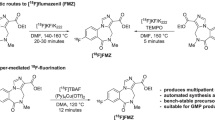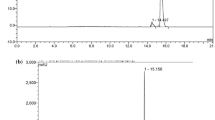Abstract
Purpose
[18F]Flumazenil, which has the advantage of a longer half-life than [11C]flumazenil, is well known for determining of the central benzodiazepine receptor concentrations. However, [18F]flumazenil has not been widely used because fluctuating and relatively low yields render automatic production insufficient for routine and multicenter clinical trials. Here, we describe the results of a 2.5-year production study of [18F]flumazenil using an iodonium tosylate precursor, which allowed us to overcome the limitations of low and fluctuating radiochemical yields.
Procedures
We developed a clinically applicable production system by modifying a commercial synthesizer for the reliable and reproducible production of [18F]flumazenil for routine clinical studies. [18F]Flumazenil was prepared at 150 °C for 5 min in the presence of 4-methylphenyl-mazenil iodonium tosylate (4 mg), a radical scavenger (TEMPO, 1 mg), and [18F]KF/kryptofix 2.2.2 complex in N,N-dimethylformamide (1 ml). In the purification step, the final mixture was pretreated using different cartridges before performing high-performance liquid chromatography (HPLC) separation. Finally, we measured the radiochemical yield and performed quality-control assays on 94 batches.
Results
After carrying out additional purification before HPLC separation using a C18 plus Sep-Pak cartridge, the radiochemical yield of [18F]flumazenil increased from 34.4 ± 9.7 % (without the pretreatment, n = 24) to 53.4 ± 9.0 % (n = 94), and the lifetime of the semi-preparative column was five times that of the column without the C18 plus Sep-Pak cartridge. The mean-specific activity of [18F]flumazenil was 572 ± 116 GBq/μmol at the end of synthesis, and the radiochemical purity was more than 99 %, as determined by analytical HPLC and radio-TLC. [18F]Flumazenil prepared using this method satisfied all quality-control test standards and was highly stable for up to 6 h after preparation.
Conclusions
The results of the 2.5-year production study using an iodonium tosylate precursor indicate that [18F]flumazenil has commercial and routine clinical applicability.




Similar content being viewed by others
References
Sieghart W (1995) Structure and pharmacology of gamma-aminobutyric acid A receptor subtypes. Pharmacol Rev 47:181–234
Pike VW, Halldin C, Crouzel C et al (1993) Radioligands for PET studies of central benzodiazepine receptors and PK (peripheral benzodiazepine) binding sites—current status. Nucl Med Biol 20:503–525
Ryvlin P, Bouvard S, Le Bars D et al (1998) Clinical utility of flumazenil-PET versus [18F]fluorodeoxyglucose-PET and MRI in refractory partial epilepsy. Brain 121:2067–2081
Savic I, Thorell JO, Roland P (1995) [11C]Flumazenil positron emission tomography visualizes frontal epileptogenic regions. Epilepsia 36:1225–1232
Savic I, Svanborg E, Thorell JO (1996) Cortical benzodiazepine receptor changes are related to frequency of partial seizures: a positron emission tomography study. Epilepsia 37:236–244
Malizia AL, Cunningham VJ, Bell CJ et al (1998) Decreased brain GABAA-benzodiazepine receptor binding in panic disorder. Arch Gen Psychiatry 55:715–720
Meyer M, Koeppe RA, Frey KA et al (1995) Positron emission tomography measures of benzodiazepine binding in Alzheimer’s disease. Arch Neurol 52:314–317
Holthoff VA, Koeppe RA, Frey KA et al (1993) Positron emission tomography measures of benzodiazepine receptors in Huntington’s disease. Ann Neurol 34:76–81
Benes FM, Vincent SL, Alsterberg G et al (1992) Increased GABAA receptor binding in superficial layers of cingulated cortex in schizophrenics. J Neurosci 12:924–929
Kiuchi Y, Kobayashi T, Takeuchi J et al (1989) Benzodiazepine receptors increase in post-mortem brain of chronic schizophrenics. Eur Arch Psychiatry Neurol Sci 239:71–78
Heiss WD, Grond M, Thiel A et al (1998) Permanent cortical damage detected by flumazenil positron emission tomography in acute stroke. Stroke 29:454–461
Heiss WD, Kracht L, Grond M et al (2000) Early [11C]flumazenil/H2O positron emission tomography predicts irreversible ischemic cortical damage in stroke patients receiving acute thrombolytic therapy. Stroke 31:366–369
Ryzhikov NN, Seneca N, Krasikova RN et al (2005) Preparation of highly specific radioactivity [18F]flumazenil and its evaluation in cynomolgus monkey by positron emission tomography. Nucl Med Biol 32:109–116
Odano I, Halldin C, Karlsson P et al (2009) [18F]Flumazenil binding to central benzodiazepine receptor studies by PET—quantitative analysis and comparisons with [11C]flumazenil. NeuroImage 45:891–902
Massaweh G, Schirrmacher E, La Fougere C et al (2009) Improved work-up procedure for the production of [18F]flumazenil and first results of its use with a high-resolution research tomography in human stroke. Nucl Med Biol 36:721–727
Mandap KS, Ido T, Kiyono Y et al (2009) Development of microwave-based automated nucleophilic [18F]fluorination system and its application to the production of [18F]flumazenil. Nucl Med Biol 36:403–409
Woodcraft J, Jones C, Gaeta A et al. (2011) Automated radiosynthesis. WO/2011/042529
Moon BS, Kil HS, Park JH et al. (2011) Facile aromatic radiofluorination of [18F]flumazenil from diaryliodonium salts with evaluation of their stability and selectivity. Org Biomol Chem 9:8346–8355
Lee BC, Kim JS, Kim BS et al (2011) Aromatic radiofluorination and biological evaluation of 2-aryl-6-[18F]fluorobenzothiazoles as a potential positron emission tomography imaging probe for β-amyloid plaques. Bioorg Med Chem 19:2980–2990
Lee BC, Dence CS, Zhou H et al (2009) Fluorine-18 labeling and biodistribution studies on peroxisome proliferator-activated receptor-gamma ligands: potential positron emission tomography imaging agents. Nucl Med Biol 36:147–153
Kwon HW, Kim YK, Shin SA et al (2012) Evaluation of cerebral glucose metabolism and GABAergic system in patients with essential tremor. J Nucl Med 53(suppl 1):2006
Kim YI, Kim YK, Yoon EJ et al (2011) Age-related changes in the availability of GABAA receptors in healthy subjects: imaging study with F-18 flumazenil PET. J Nucl Med 52(suppl 1):1209
Yoon HJ, Lee HY, Kang H et al (2012) Clinical utility of flumazenil PET versus FDG PET and MRI in intractable epilepsy patients: prospective study with a statistical parametric mapping method. J Nucl Med 53(suppl 1):38
Kim YK, Yang EJ, Cho K et al (2014) Functional recovery after ischemic stroke is associated with reduced GABAergic inhibition in the cerebral cortex: A GABA PET study. Neurorehabil Neural Repair. doi:10.1177/1545968313520411
Acknowledgments
This study was supported by grants (HI09C-1444-010013, 20090078370, HI12C-0035-030013, and 2012R1A1A2005887) from the government of South Korea. In addition, this study was supported by grant no. 11-2012-003 from the SNUBH research fund. We would like to give a special thank to Bio Imaging Korea Co., Ltd., which had provided the necessary iodonium tosylate precursors.
Conflict of Interest
The authors have no conflicts of interest.
Author information
Authors and Affiliations
Corresponding author
Rights and permissions
About this article
Cite this article
Moon, B.S., Park, J.H., Lee, H.J. et al. Routine Production of [18F]Flumazenil from Iodonium Tosylate Using a Sample Pretreatment Method: a 2.5-Year Production Report. Mol Imaging Biol 16, 619–625 (2014). https://doi.org/10.1007/s11307-014-0738-z
Published:
Issue Date:
DOI: https://doi.org/10.1007/s11307-014-0738-z




